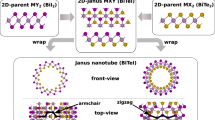Abstract
Since the discovery of carbon nanotubes1, it has been speculated that these materials should behave like nanoscale wires with unusual electronic properties and exceptional strength. Recently, ‘ropes’ of close-packed single-wall nanotubes have been synthesized in high yield2. The tubes in these ropes are mainly of the (10,10) type3, which is predicted to be metallic4,5,6. Experiments on individual nanotubes and ropes7,8 indicate that these systems indeed have transport properties that qualify them to be viewed as nanoscale quantum wires at low temperature. It has been expected that the close-packing of individual nanotubes into ropes does not change their electronic properties significantly. Here, however, we present first-principles calculations which show that a broken symmetry of the (10,10) tube caused by interactions between tubes in a rope induces a pseudogap of about 0.1 eV at the Fermi level. This pseudogap strongly modifies many of the fundamental electronic properties: we predict a semimetal-like temperature dependence of the electrical conductivity and a finite gap in the infrared absorption spectrum. The existence of both electron and hole charge carriers will lead to qualitatively different thermopower and Hall-effect behaviours from those expected for a normal metal.
This is a preview of subscription content, access via your institution
Access options
Subscribe to this journal
Receive 51 print issues and online access
$199.00 per year
only $3.90 per issue
Buy this article
- Purchase on Springer Link
- Instant access to full article PDF
Prices may be subject to local taxes which are calculated during checkout



Similar content being viewed by others
References
Iijima, S. Helical microtubules of graphitic carbon. Nature 354, 56–58 (1991).
Thess, A.et al. Crystalline ropes of metallic carbon nanotubes. Science 273, 483–487 (1996).
Cowley, J. M., Nikolaev, P., Thess, A. & Smalley, R. E. Electron nano-diffraction study of carbon single-walled nanotube ropes. Chem. Phys. Lett. 265, 379–384 (1997).
Hamada, N., Sawada, S. & Oshiyama, A. New one-dimensional conductors: graphitic microtubules. Phys. Rev. Lett. 68, 1579–1581 (1992).
Mintmire, J. W., Dunlap, B. I. & White, C. T. Are fullerene tubules metallic? Phys. Rev. Lett. 68, 631–634 (1992).
Saito, R., Fujita, M., Dresselhaus, G. & Dresselhaus, M. S. Electronic structure of chiral graphene tubules. Appl. Phys. Lett. 60, 2204–2206 (1992).
Tans, S. J.et al. Individual single-wall carbon nanotubes as quantum wires. Nature 386, 474–477 (1997).
Bockrath, M.et al. Single-electron transport in ropes of carbon nanotubes. Science 275, 1922–1925 (1997).
Krotov, Y. A., Lee, D.-H. & Louie, S. G. Low energy properties of (n, n) nanotubes. Phys. Rev. Lett. 78, 4245–4248 (1997).
Cohen, M. L. & Chelikowsky, J. R. Electronic Structure and Optical Properties of Semi-conductors, 20 (Springer, Berlin, 1988).
Charlier, J.-C., Gonze, X. & Michenaud, J.-P. First-principles study of the stacking effect on the electronic properties of graphites. Carbon 32, 289–299 (1994).
Charlier, J.-C., Gonze, X. & Michenaud, J.-P. First-principles study of carbon nanotube solid-state packings. Europhys. Lett. 29, 43–48 (1995).
Song, S. N., Wang, X. K., Chang, R. P. H. & Ketterson, J. B. Electronic properties of graphite nanotubules from galvanomagnetic effects. Phys. Rev. Lett. 72, 697–700 (1994).
Langer, L.et al. Quantum transport in a multiwalled carbon nanotube. Phys. Rev. Lett. 76, 479–482 (1996).
Acknowledgements
We thank V. Crespi for discussions and for providing relaxed atomic coordinates. This work was supported by the NSF and DOE. P.D. thanks the NUI for support; H.J.C. and J.I. were supported by the BSRI program of the Ministry of Education of Korea and the SRC program of KOSEF; and S.G.L. acknowledges the hospitality of the Aspen Center for Physics.
Author information
Authors and Affiliations
Corresponding author
Rights and permissions
About this article
Cite this article
Delaney, P., Choi, H., Ihm, J. et al. Broken symmetry and pseudogaps in ropes of carbon nanotubes. Nature 391, 466–468 (1998). https://doi.org/10.1038/35099
Received:
Accepted:
Issue Date:
DOI: https://doi.org/10.1038/35099
This article is cited by
-
Thermoelectric properties of a vertically aligned carbon nanotube array with embedded bismuth telluride
Journal of Materials Science (2022)
-
Engineering symmetry breaking in 2D layered materials
Nature Reviews Physics (2021)
-
Carbon nanotube-reinforced intermetallic matrix composites: processing challenges, consolidation, and mechanical properties
The International Journal of Advanced Manufacturing Technology (2019)
-
The Effect of Various Catalyst on In-situ Synthesis of Carbon Nanotubes on the Glass Mat Using Thermal Chemical Vapor Deposition Method
Fibers and Polymers (2018)
-
Compressed carbon nanotubes: A family of new multifunctional carbon allotropes
Scientific Reports (2013)
Comments
By submitting a comment you agree to abide by our Terms and Community Guidelines. If you find something abusive or that does not comply with our terms or guidelines please flag it as inappropriate.



